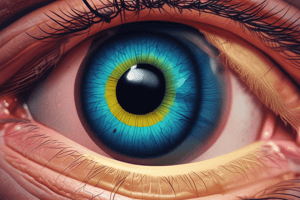Podcast
Questions and Answers
A patient reports difficulty seeing objects up close. Which refractive error is most likely affecting their vision?
A patient reports difficulty seeing objects up close. Which refractive error is most likely affecting their vision?
- Astigmatism
- Emmetropia
- Myopia (correct)
- Hyperopia
An elderly patient is diagnosed with presbyopia. What visual change is most closely associated with this condition?
An elderly patient is diagnosed with presbyopia. What visual change is most closely associated with this condition?
- Narrowing of the visual field (correct)
- Clouding of the lens
- Loss of central vision
- Increased sensitivity to light
What is the priority nursing intervention when encountering a patient with significant vision loss?
What is the priority nursing intervention when encountering a patient with significant vision loss?
- Orienting the patient to the immediate surroundings (correct)
- Assessing the patient's pupillary response
- Administering prescribed eye drops immediately
- Measuring the patient's intraocular pressure
Following cataract surgery with lens replacement, a patient should be educated to avoid activities that increase intraocular pressure. Which activity should the nurse advise the patient to avoid?
Following cataract surgery with lens replacement, a patient should be educated to avoid activities that increase intraocular pressure. Which activity should the nurse advise the patient to avoid?
A patient is prescribed timolol eye drops for glaucoma. What is an important consideration when administering this medication?
A patient is prescribed timolol eye drops for glaucoma. What is an important consideration when administering this medication?
A patient presents with a red sclera and exudate in their eye. Which intervention is most appropriate?
A patient presents with a red sclera and exudate in their eye. Which intervention is most appropriate?
A patient reports a sensation of 'ringing in the ears.' What term should the nurse use to document this symptom?
A patient reports a sensation of 'ringing in the ears.' What term should the nurse use to document this symptom?
A patient is diagnosed with conductive hearing loss. What is a common cause of this type of hearing impairment?
A patient is diagnosed with conductive hearing loss. What is a common cause of this type of hearing impairment?
When administering ear drops to an adult, which technique is most appropriate to optimize medication delivery?
When administering ear drops to an adult, which technique is most appropriate to optimize medication delivery?
A patient with vertigo is prescribed an anticholinergic drug. What is the primary reason for this medication in the context of vertigo management?
A patient with vertigo is prescribed an anticholinergic drug. What is the primary reason for this medication in the context of vertigo management?
Flashcards
Emmetropia
Emmetropia
Ideal refraction, resulting in perfect vision.
Hyperopia
Hyperopia
Farsightedness; difficulty seeing objects up close.
Myopia
Myopia
Nearsightedness; difficulty seeing objects far away.
Astigmatism
Astigmatism
Signup and view all the flashcards
Miosis
Miosis
Signup and view all the flashcards
Mydriasis
Mydriasis
Signup and view all the flashcards
Presbyopia
Presbyopia
Signup and view all the flashcards
Arcus Senilis
Arcus Senilis
Signup and view all the flashcards
Ptosis
Ptosis
Signup and view all the flashcards
Anisocoria
Anisocoria
Signup and view all the flashcards
Study Notes
- Sensory study involves eyes and vision
Eye and Vision
- Emmetropia refers to perfect vision with ideal refraction.
- Hyperopia is farsightedness, making it easier to see distant objects clearly.
- Myopia is nearsightedness, allowing one to see nearby objects clearly.
- Astigmatism arises from an uneven curvature of the cornea or eye.
- Miosis is pupillary constriction.
- Mydriasis refers to pupillary dilation.
- Presbyopia is the narrowing of the visual field due to age.
- Arcus senilis is an opaque blue rim around the cornea’s outer edge.
- Ptosis is the dropping of the eyelid.
- Mild ptosis involves a 2 mm droop.
- Moderate ptosis involves a 3 mm droop.
- Severe ptosis involves a droop of 4 mm or more.
- Anisocoria is the condition of having unequal pupils.
Patient with Vision Loss
- When approaching a patient with vision loss, it's important to:
- Knock before entering
- Announce your name and title
- Help them orient to the room using a focal point
- Help them orient to the table/plate with the clock method.
- Ensure their safety
- Explain everything you do before you do it
After Lens Replacement Surgery
- Avoid increasing intraocular pressure
- Measures to take:
- Avoid bending at the waist
- Avoid lifting more than 10 pounds
- Avoid sneezing or coughing
- Avoid blowing the nose forcefully
- Avoid straining during bowel movements
- Avoid vomiting
- Avoid sexual intercourse
- Avoid placing the head in a dependent position
- Avoid wearing tight shirt collars
Glaucoma
- Glaucoma results in increased IOP (Intraocular Pressure).
- Managed with eye drops and careful intraocular pressure monitoring (regular visits).
- Timolol (BBD eye drop) can be absorbed systemically, educate the patient about holding pressure in the inner canthus for a full minute.
Corneal Disorders
- Abrasion
- Can be treated by irrigating the eyes
- Ulceration
- Infection
- Can be identified through a red sclera and presence of exudate/crusts
- Use oral or topical antibiotics
- Prevent transmission
- Use warm compresses
- Pain management
- Prescribed medication
Retinal Disorders
- Macular degeneration is linked to hypertension.
- Retinal holes, tears, and detachment are also linked to hypertension.
Eye Irrigation
- Remove particles or flush the eye from chemical exposure.
- Do NOT use with eye trauma like lacerations or penetration of the globe.
Ears
- Hypercusis is the intolerance of normal sound levels.
- Presbycusis is hearing loss associated with age.
- Tinnitus is a ringing in the ear.
- Cerumen is ear wax.
Hearing Loss
- Conductive hearing loss is due to an obstruction of sounds, such as a foreign body/wax, OM (otitis media), TM (tympanic membrane) changes, fused bony ossicles
- Sensorineural hearing loss is due to cochlear defect, 8th cranial nerve defect, or brain defect, or loud sounds that can damage cochlear hair
- Mixed conductive-sensorineural hearing loss is a mix of both.
Patient with Hearing Loss
- Ensure adequate lighting.
- Reduce distracting sounds.
- Determine the preferred communication method.
- Allow extra time for questions and to assess understanding.
- Use a sign language interpreter if the patient can sign.
Otitis Media
- Watch for sudden pain relief, could signify rupture.
- Check the TM if concerned about rupture prior to administering ear drops (some cannot be used if TM is not intact).
Ear Drops
- Ensure to warm the drops.
- Angle upwards for adults.
- Angle downwards for kids.
- Stay on the ear side for at least 2 minutes.
Vertigo
- Meniere's disease
- Nystagmus
- Anticholinergic drugs
- Including antihistamine, antiemetic, and antivertiginous
- Safety is a priority
- Use anticholinergic drugs to decrease the risk of falls and improve safety
Studying That Suits You
Use AI to generate personalized quizzes and flashcards to suit your learning preferences.




